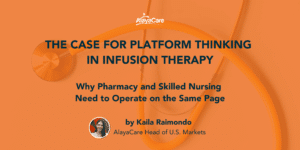Originally Published in the Austin American Statesman
http://www.mystatesman.com/news/opinion/nyquist-medicare-cuts-are-wrong-for-those-with-rheumatoid-arthritis/BndtzDJdnnNtLhEAoEkXJL/
More than 1.5 million Americans are living with rheumatoid arthritis.
A diagnosis is life-altering, as RA causes chronic swelling and pain and increases the risk of heart attack, stroke, and depression. After learning they have the disease, many patients head to their local Infusion Center for treatment, as many of the best medicines for RA are delivered intravenously.
But if Medicare officials in Washington proceed with a new plan to cut Medicare funding, many of these centers will close or be forced to turn away patients who need these advanced treatments. This proposal, which impacts Medicare Part B, will deny patients convenient access to the medicines they depend on. It must be shelved.
Most patients with RA, cancer, osteoporosis, and other serious conditions rely on medicines that are delivered intravenously, under the supervision of a doctor. Today, clinics and infusion centers buy these medicines directly — and then Part B reimburses them the drug’s average sales price plus another 4.3 percent, which accounts for administrative costs, storage, overhead and more.
Medicare officials plan to slash the reimbursement rate to the average sales price plus 0.9 percent and an additional flat fee of $16.80 per dose. That would drastically lower the reimbursement rate for advanced drugs while raising it for dated, less-expensive medicines.
For some patients, the change won’t matter, as the drugs they need have been on the market for decades. But for many patients — especially those with chronic, autoimmune diseases like RA — the best drugs are the newest, most-advanced medicines without cheaper alternatives. Physicians will struggle to offer such drugs under Medicare’s proposal, so many will refer their patients to hospitals that can afford to carry the drugs.
Heading to a large hospital generally means longer travel and wait times. And because treatment costs are higher at hospitals, taxpayers will suffer, too. Marcia Boyle, president and founder of the Immune Deficiency Foundation, even recently warned Congress about these inconveniences, stating: “It [the proposed rule] indicates an incredibly cavalier and patronizing attitude by the agency towards beneficiaries. No Medicare beneficiary should have to travel farther to a more expensive setting.”
By being sent to big hospitals for treatment, patients with these diseases also will lose the personalized care of their clinic doctors. As Rose Gerber, the director of patient advocacy and education at the Community Oncology Alliance put it, Medicare “is wedging itself between the patient and his or her physician.”
No patient should be denied convenient access to the most cutting-edge treatments because federal bureaucrats make it impossible for doctors to use such medicines.
Some centers will even be forced to close.
Clinics and infusion centers barely break even under the current formula. Repeated Medicare cuts have reduced reimbursements for infusion of a “high-level” medication by 24 percent from 2006 to 2014. As a result, the average center earns a margin of just 1 or 2 percent treating Medicare patients.
With so many centers treading water, this new round of reimbursement cuts would drown clinics and centers in red ink. In 2013, when officials last cut the reimbursements rate, dozens of cancer clinics closed and acquisitions by hospitals increased 20 percent.
Right now, when patients receive a diagnosis of RA, cancer, or another serious disease, many find comfort in the knowledge that they’ll have access to miracle drugs that previous generations could only dream of — and that their doctor will be by their side throughout the treatments.
But if Medicare officials move forward with their plan, that could end. Further cuts will significantly reduce access to these life-changing medications, forcing many infusion centers to shut down or to refer patients elsewhere. The changes will dash hundreds of thousands of sick Americans’ hopes for a brighter future — and all for an effort to shave costs.




